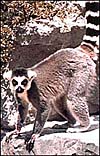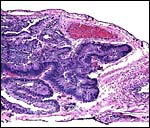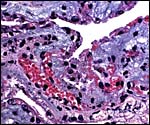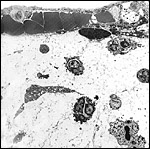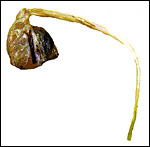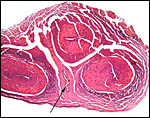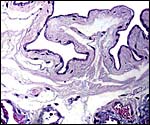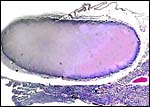|
(Clicking
on the thumbnail images will launch a new window and a larger version
of the thumbnail.)
|
| Last updated: Aug 15, 2005. |
Lemur catta
Order: Primates
Family: Lemuridae
1) General Zoological Data
There are numerous lemur species, all from Madagascar (Malagasy Republic) or from the Comoro Islands. They vary greatly in appearance but the surviving species vary only slightly in size. Many species have become extinct in the recent past (Ziswiler, 1967). I have had experience with ruffed lemurs, (Varecia spp.), ring-tailed lemurs (Lemur catta), and with black lemurs (Lemur macaco). Their placentation is generally similar and for that reason only the ring-tailed lemur species will be dealt with here in some detail. (See also the chapter on "Ruffed Lemurs" and “Brown lemur”.)
All lemurs are significantly endangered now. This is one reason why so many breeding colonies exist in zoos of various countries. Most notably, lemurs are well represented in the Vincennes Zoo of Paris and at the Primate Center of Duke University, Durham, North Carolina. There are some exceptionally rare species at those locations. The management of lemurs in captivity has been aptly discussed by Puschmann (1989). Longevity of ring-tailed lemurs is 19 years (Bogart et al., 1977).
The body weight of lemurs is around 2,000 g; they have long tails and thick fur. Lemurs are mostly arboreal forest dwellers (Nowak & Paradiso, 1983) and most are primarily diurnally active; a few other species not discussed here are more nocturnal. They often occur in sizeable groups and are largely vegetarian. There is an abundant literature on these well-studied prosimians.
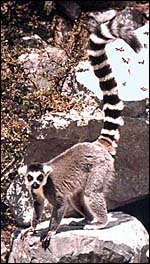 |
Ring-tailed lemur at San Diego Zoo (Lemur catta). |
Ring-tailed lemurs have a gestation of 136 days or less. Singletons are the rule but dizygotic twins are also common (Pasztor & van Horn, 1976; Benirschke & Miller, 1981). The latter publication also details the growth increments of a hand-raised ring-tailed lemur. Ring-tailed lemurs have an estrous cycle of 30 day, with estrus being around 6 days. The weight of newborn ring-tailed lemurs is only 25-50 g.
3)
Implantation
Early embryonic/placental stages of these animals have not been described.
Mossman (1987), however, suggested that implantation occurs in an antimesometrial
location. The final seat of the diffuse singleton lemur placenta is one
that extends throughout the bicornuate uterus.
4)
General Characterization of the Placenta
Two placentas from a set of twins were available from the San Diego Zoo
weighing 8.3 and 7.5 g. They were not fused. The respective neonates weighed
54.2 and 35. 2 g. In addition, I have had one placenta made available
by the Duke University Primate Center. It was formalin fixed and weighed
6.7 g. It measured 7 x 5 x 0.2 cm and had a brownish coloration. As other
lemurs, it was a diffuse, villous placenta that presumably occupied the
entire bicornuate uterus. The nidation of lemur placentas is superficial
(Mossman, 1987) and their placenta is epitheliochorial. There is a large
allantoic sac but lemurs have no invasive trophoblast.
An additional placenta from Dean Gibson at the Duke Primate Center weighed 6.3 g and had a 9 cm umbilical cord.
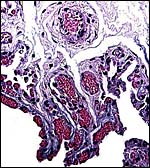 |
Chorion above with vascular villi below. Note the capillary indentation into the single-layered trophoblast. |
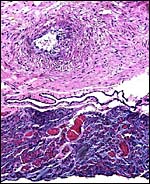 |
Compressed placental tissue beneath thick chorionic plate with large fetal vessel. |
This placenta, like that of other lemurs, is typically epithelio-chorial with villi merely approximating the uterine epithelium. They are superficially attached to the undamaged uterine epithelium. The trophoblastic surface of villi is underlain by a dense capillary network and the capillaries often indent the very thin trophoblastic epithelium. Numerous macrophages (Hofbauer cells) and occasional leukocytes are found in the villous stroma.
The umbilical cords of lemurs are short, but none of these was measured. That of the last specimen was extremely short and had the usual three blood vessels. There were no spirals. Its surface was covered with thin amnionic epithelium. A widely patent allantoic duct was found in all specimens.
7)
Uteroplacental circulation
This has not been described.
8)
Extraplacental membranes
A large allantoic sac was present in all specimens that is connected to
the bladder by a wide allantoic duct of the umbilical cord. The allantois
is lined by prominent cuboidal epithelium (see Benirschke & Miller,
1982, Fig. 1). Since this is a diffuse placenta, there are no free membranes.
Thus, there is also no decidua capsularis. The umbilical cord of another term lemur gestation was kindly made available by Dean Gibson of the Duke Primate Center . It measured 9 cm in length and had no twists. The next photograph is of that specimen after formalin fixation.
There is no invasion of the endometrium.
10)
Endometrium
There is no decidualization of the endometrium. In postpartum uteri of
other lemurs I have found hemosiderin granules.
11)
Various features
None.
12)
Endocrinology
No gonadotropins have been identified in lemurs.
Urinary estrogens were monitored during pregnancy by Shideler et al. (1983).
Total urinary estrogen excretion rose significantly during gestation until
they reached values 1,000 times of those at estrus. Estrone was the major
secretory product.
13)
Genetics
Lemur catta has a diploid number of 2n=56 (Hsu & Benirschke, 1970).
The Y chromosome is a small acrocentric element. Hybrids have not been
described.
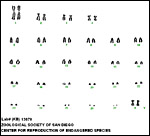 |
Karyotype of female ring-tailed lemur. |
I know of no studies that relate to immunological investigations.
15)
Pathological features
Griner (1983) found that, among the large number of prosimians autopsied
by him, ring-tailed lemurs had the fewest mortalities. Most of his specimens
were due to trauma or deficient neonatal care. Hemosiderosis and hepatic
tumors have been a problem in ruffed lemurs and these conditions are detailed
in that chapter.
16) Physiologic data
I know of no blood flow studies before and during pregnancy. We have studied
the absorption of iron in ruffed lemurs and found them to have a great
avidity for dietary iron. This, we interpreted to be the result of their
dependence in nature on tannic acid-containing food such as tamarind fruit
(Gonzales et al., 1984). Administration of tea instead of water has reduced
this problem in captivity.
17) Other resources
Cell strains of many species of lemurs and related taxa are available
from CRES at the Zoological Society of San Diego by contacting Dr. O.
Ryder at: oryder@ucsd.edu.
18)
Other remarks - What additional Information is needed?
No implanted placenta of a ring-tailed lemur has been described and the
uterine circulation needs study.
Acknowledgement
The animal photograph in this chapter comes from the Zoological Society
of San Diego. I appreciate also very much the submission of one specimen
by Deane Gibson of the Duke University Primate Center in Durham, NC.
References
Benirschke, K. and Miller, C.J.: Weights and neonatal growth of ring-tailed lemurs (Lemur catta) and ruffed lemurs (Lemur variegatus). J. Zoo Anim. Med. 12:107-111, 1981.
Benirschke, K. and Miller, C.J.: Anatomical and functional differences in the placenta of primates. Biol. Reprod. 26:29-53, 1982.
Bogart,
M.H., Cooper, R.W. and Benirschke, K.: Reproductive studies of Lemur
m. macaco, Lemur variegatus subcinctus and Lemur v. ruber.
Internat. Zoo Yrbk. 17:177-182, 1977.
Gonzales, J., Benirschke, K., Saltman, P., Roberts, J. and Robinson, P.T.:
Hemosiderosis in lemurs. Zoo Biol. 3:255-265, 1984.
Griner, L.A.: Pathology of Zoo Animals. Zoological Society of San Diego, San Diego, California, 1983.
Hsu, T.C. and Benirschke, K.: An Atlas of Mammalian Chromosomes. Volume 4: Folio 194. Springer-Verlag, New York, 1970.
Mossman, H.W.: Vertebrate Fetal Membranes. MacMillan, Houndmills, UK, 1987.
Nowak, R.M. and Paradiso, J.L.: Walker's Mammals of the World, Vol. II. 4th edition. The Johns Hopkins University Press, 1983.
Pasztor, L.M. and van Horn, R.N.: Twinning in prosimians. J. Human Evol. 5:333-337, 1976.
Puschmann, W.: Zootierhaltung. Vol. 2 Säugetiere. VEB Deutscher Landwirtschaftsverlag, Berlin, 1989.
Shideler, S.E., Czekala, N.M., Benirschke, K. and Lasley, B.L.: Urinary estrogens during pregnancy of the ruffed lemur (Lemur variegatus). Biol. Reprod. 28:963-969, 1983.
Ziswiler, V.: Extinct and Vanishing Animals. Springer-Verlag, New York, 1967.
